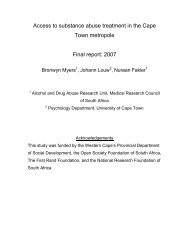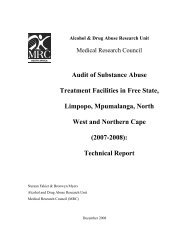Pan-African Conference 21 - 24 July 2002 Inter-Continental Hotel ...
Pan-African Conference 21 - 24 July 2002 Inter-Continental Hotel ...
Pan-African Conference 21 - 24 July 2002 Inter-Continental Hotel ...
Create successful ePaper yourself
Turn your PDF publications into a flip-book with our unique Google optimized e-Paper software.
Abstracts 10/22/02 11:26 AM Page 7<br />
system comprehensively covering prevention and control of iron deficiency<br />
research and interventions. This period also focused on promoting<br />
participation and use of IDPAS services among international organizations,<br />
NGOs, bilateral agencies, universities and project personnel throughout the<br />
developing world.<br />
The second, current phase of the project aims at extending Iron World much<br />
more actively into field level project operations, in a number of selected<br />
countries. The objectives are to supply specific information and technical<br />
advice to more of those doing research, and supporting and implementing<br />
interventions related to iron nutrition. However, this phase of network<br />
development also aims toward developing more active “populating” Iron<br />
World more information on the experience of its users and more active sharing<br />
of experiences among them. To better balance information reports based on<br />
laboratory and field research, IDPAS is actively exploring mechanisms aimed<br />
at drawing out and sharing practical, field level operational experiences.<br />
Initial efforts demonstrate the challenges of proactive networking. Identifying<br />
the core group of those working on research and relevant projects in <strong>African</strong><br />
countries, reaching them by means other than an actual visit, and finding<br />
effective and acceptable means for encouraging them to share experiences are<br />
difficult.<br />
The experiences of IDPAS in developing both a global technical information<br />
service and in trying to develop a proactive networking model should be<br />
useful for those working in several other technical fields of nutrition,<br />
particularly if barriers to communication among those working in related<br />
fields can be overcome and a genuine epistemic and virtual community can be<br />
developed.<br />
IT and food security / La TI dans l’évaluation de la sécurité alimentaire<br />
Dr. Helen Hambly Odame<br />
Research Officer<br />
ISNAR (<strong>Inter</strong>national Service for National Agricultural Research), The<br />
Netherlands<br />
The world has the tools, wealth, food and know-how to fight poverty and<br />
hunger. This may be no surprise to those us who as individuals or<br />
organizations work in nutrition and agricultural research and development.<br />
Yet the extraordinary actions to prevent 800 million people in the world being<br />
undernourished in 2010 are sadly lacking. The largest proportion of people<br />
who suffer from this inaction lives in Africa.<br />
To what extent can IT be an opportunity to achieve food security through<br />
improved assessment and action? If less than one in one hundred <strong>African</strong>s<br />
have any access at all to a single modern information technology (i.e. a radio,<br />
a telephone, a fax, the <strong>Inter</strong>net, etc.) is IT the means for a digital divide or a<br />
digital bridge?<br />
The conceptual basis of this paper rests on the sharing of knowledge and<br />
participatory assessment, and not the control and release of information. To<br />
this end, the experiences of various international interventions related to IT<br />
and nutrition in Africa are discussed. The agencies include the CTA, the<br />
CGIAR, IICD, UNESCO, IDRC and others. Links with national partners in<br />
Africa and the role of critical stakeholders such as rural women and youth are<br />
emphasized. The paper concludes by suggesting that only if IT engages fully<br />
with social communication and learning will it impact universal food security.<br />
IT in nutritional status assessment / La TI dans l’évaluation nutritionnelle<br />
Leif Hambræus, MD PhD<br />
Professor emeritus, Unit for Preventive Nutrition, Dept of Bioscience,<br />
Karolinska Institutet at Novum, Sweden<br />
Too low as well as too high intakes of energy and nutrients may to some extent<br />
be compensated by changes in body stores, reflected by changes in body<br />
composition. However, sooner of later it leads to disturbances in the metabolic<br />
regulation resulting into malnutrition disease. Deficiency of energy or one or<br />
more nutrients, malnutrition minus, leads to more or less well-defined<br />
deficiency diseases and increased susceptibility to infections. A surplus of<br />
energy or nutrient intake also leads to long-term deleterious effects, often<br />
referred to as malnutrition plus, i.e. obesity, cardiovascular disease.<br />
Nutritional epidemiology depends on valid assessment of nutritional status of<br />
individuals and populations. For any preventive health care measures, it is<br />
essential to find methods to identify individuals and populations at risk at an<br />
early stage. as well as exposure of individuals to various risk factors.<br />
In the flow sheet of various methods and diagnostic tools used to assess<br />
ABSTRACTS<br />
nutritional status, the assessment of dietary intakes by various record and<br />
recall methods may offer possibilities to identify risk groups at an early stage.<br />
Changes in body composition as result of reduced stores of nutrients and<br />
changed plasma levels may be used as biomarkers of potential malnutrition<br />
before any clinical symptoms and signs have developed. Clinical data are,<br />
however, relatively late results of malnutrition. The final outcome of the health<br />
effect of malnutrition is revealed by morbidity and mortality data in health<br />
statistics.<br />
All above mentioned methods for assessment of nutritional status benefit from<br />
the use of computer technology. Valid data on dietary intake are depending on<br />
(1) accurate food databases available on the net or CD; and (2) data processing<br />
procedures of results obtained from food questionnaires as well as dietary<br />
records and recalls, to express the results in relation to recommended daily<br />
allowances (RDA). Local or regional valid data on RDA should preferably be<br />
used as references. Computer-assisted self-interviewing programs may prove<br />
to be an economic approach to assess dietary intake not only of nutrients but<br />
also of potential food-borne exposures in a population. In order to evaluate the<br />
accuracy of dietary intake it is also essential to analyse body composition and<br />
physical activities for indirect estimation of energy balance.<br />
Specific computer assessment programs have also been developed for<br />
assessment of nutritional status.. These are based on a number of<br />
measurement techniques including nutrient intake, body composition data<br />
and exercise. Many of the programmes take advantage of interactive health<br />
communications technologies in order to screen multiple behaviours and<br />
initiate interventions, for making nutrition and exercise plans for athletes as<br />
well as patients. This also makes it possible to combine assessment of<br />
nutritional status with nutrition education and information. It is understood<br />
that health statistics comprising morbidity and mortality data in relation to<br />
dietary intakes are almost completely depending on accurate data processing<br />
procedures.<br />
Information technology and use of computer analysis as well as interactive<br />
communication technologies have the potential to eliminate and greatly<br />
reduce many of the barriers to analyse nutrition assessment data and support<br />
nutrition education of the public.<br />
Communicating nutrition research: obstacles and opportunities through IT /<br />
Communication de la recherche nutritionnelle: obstacles et opportunités par<br />
la TI<br />
Nik Harvey<br />
<strong>Inter</strong>national Food Policy Research Institute (IFPRI), USA<br />
As nutrition researchers rise to face the challenges surrounding food policy<br />
issues, information technology (IT) is greatly enhancing their work. IT is<br />
revolutionizing the field by allowing for greater accuracy in data collection,<br />
quicker information sharing and new methods of teaching and learning. IT is<br />
also being introduced as a tool to effectively communicate nutrition research<br />
and strengthen the linkage between nutrition science and public policy<br />
formulation. The goal of IT is not simply wiring houses and classrooms; it is<br />
bringing information to people whom are deprived of it.<br />
The challenge for nutrition communications is to expand the use of IT in<br />
regions where technology is limited, unreliable or too costly. Considering the<br />
principles of techno-realism, it is important to note that IT is not the ultimate<br />
solution to nutrition communications, and should not be the focal point of any<br />
communications strategy for developing countries. IT should be viewed as a<br />
means of assisting knowledge transfer, and augmenting communications.<br />
Since usage of IT varies by location, it is also important to consider IT within<br />
the capacity that it is available.<br />
Communicating Nutrition to Policymakers<br />
While improving nutrition appears to be a moral imperative, nutrition as a<br />
means for economic and social development is an illusive concept for many<br />
policymakers. To communicate nutrition requires information that “sells” the<br />
issue, convincing policymakers and their advisors of its importance. Since<br />
policymakers receive information from a variety of sources, the extent to<br />
which policymakers use IT for nutrition information is debatable. However,<br />
policy advisors are looking to IT for information, as well as traditional<br />
mediums.<br />
Communicating Urban Nutrition<br />
Urban growth in developing countries affects nutrition, and many of these<br />
countrys’ urban food security policies need to be reevaluated. Unfortunately,<br />
communicating nutrition information is difficult because many urban<br />
policymakers focus more on squalid environments, security and<br />
infrastructure. As cities grow, urban food security is often crowded out of the<br />
public policy agenda.<br />
S7

















